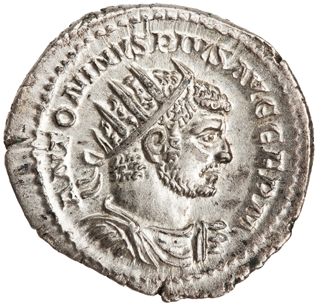| Back to Monetary reform of Augustus in 23 BC | This page is part of the article Getting Started with Roman Coins | Forward to Monetary Reform of Aurelian in 270-274 AD |
In 215 AD Caracalla introduced the Double Aureus and the Antoninianus. The Double Aureus was an honest coin, being worth two Aurei and having the gold content of two Aurei. Actual coin weights show this although some sources claim a lower weight. The Antoninianus, however, was a scam used to try and cope with ever increasing military expenses and general bad management. It was worth two Denarii, but only contained the silver of one and a half Denarii. The portrait on the Antoninianus wears a radiate crown to distinguish the coin from the Denarius (for females, the bust rests in a crescent).
| Male | Female | |
| Denarius | ||
| Antoninianus |
Denominations from around 215 AD:
| Metal | Denomination | Value (Asses) | Value (Denarius) | Weight |
| Gold | Double Aureus | 800 | 50 | 13.2g |
| Aureus | 400 | 25 | 6.5g | |
| Quinarius aureus | 200 | 2.5 | 3.66g | |
| Silver | Antoninianus (also known as a “Radiate”) | 32 | 2 | 5.09g |
| Denarius | 16 | 1 | 3.23g | |
| Quinarius | 8 | ½ | 1.32g | |
| Orichalcum | Sestertius | 4 | ¼ | 24.6g |
| Dupondius | 2 | 1/8 | 12g | |
| Copper | As | 1 | 1/16 | 10.7g |
Between 215 AD and 272 AD, silver coins were continually debased, with the Antoninianus falling from 52% silver to 2.64% silver:
215 AD 52% | 238 AD 49% | 251 AD 36% | 253 AD 22% | 255 AD 17% |
262 AD 15% | 265 AD 9% | 267 AD 6% | 268 AD 3.16% | 271 AD 2.64% |
All photos Copyright American Numismatic Society (CC BY-NC 4.0)
Article Navigation
| Back to Monetary reform of Augustus in 23 BC | Up to The Imperial Period (27 BC to 476/491/498 AD) | Forward to Monetary Reform of Aurelian in 270-274 AD |














